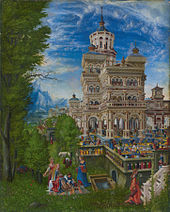Susanna in the bath

As Susanna and the Elders , and Susanna and the (two) elders that is biblical story of the rescue of Susanna by the prophet Daniel called. The story is known by the first name not only in the visual arts, but also in law and crime fiction .
text
The Greek text is available in two different versions, the early Septuagint version (Sus LXX ) and a new version created around 100 years later, the so-called Theodotion version (Sus Th ). Due to a Greek pun in verses 54-55 and 58-59 ( ancient Greek σχίνον> σχῖνος , mastic tree ' and σχίσει> σχίζω , columns' ; πρίνον> πρῖνος , oak ' and καταπρίσει> -πρίζω; -πρίω , saw off' ), it is assume that the book was originally written in Greek.
The story in the Bible




The story of Susanna is not yet included in the Aramaic version of the Book of Daniel , which is part of the Jewish canon of holy scriptures. The Septuagint offers an expanded Greek text that also contains the pericope of Susanna in the bath. It is followed by the Latin Vulgate and with it the Roman Catholic Bible tradition. So Susanna in the bath is also part of the Daniel book in the German standard translation . While it appears at the beginning of the book of Daniel in the Greek Bible, it is at the end of the Vulgate, and thus also in the standard German translation. In evangelical translations of the Bible, the pericope appears in the Apocrypha of the Old Testament ( pieces from the Book of Daniel ).
According to Dan 13: 1-64 EU there lived in Babylon a rich man named Jojakim, who was married to a beautiful and pious woman named Susanna. Two highly respected old judges frequented his house and fell in love with Susanna. In the Bible it says: Then the desire for her arose in them. Her thoughts got astray and her eyes went astray. ( Dan 13.9 EU )
They secretly ambushed the woman in the garden when she wanted to take a bath. They harassed them and tried to force them to sleep with them. They threatened to otherwise accuse her of committing adultery with a young man. But Susanna stood firm, refused and screamed. The two elders also shouted loudly, arrested Susanna and said they had surprised her in adultery. They then publicly tried Susanna and sentenced her to death. When the sentence was about to be carried out, Daniel was inspired by the Holy Ghost and interrogated the two witnesses . He asked her independently under which tree Susanna is said to have cheated on her husband. While one said she did it under a cedar tree , the other said it was an oak . Then the Jewish authorities and the listening people also recognized the two liars, and Susanna was released. The two false witnesses were killed.
meaning
Apart from its religious significance, history is considered to be groundbreaking in the development of case law, because it emphasizes the principle of independent questioning of witnesses, which is still important today.
In addition, numerous representatives of the visual arts have taken on this topic. It probably also played a role that the motif, as a biblical theme, offered a legitimate reason for depicting nudes . Artemisia Gentileschi looks at the subject from a different perspective : She dispenses with romantic attributes and focuses on Susanna and her precarious situation.
Numerous painters from different epochs have taken on the subject of "Susanna in the bath", including: Rembrandt , Peter Paul Rubens , Massimo Stanzione , Jacopo Tintoretto and contemporary Moran Haynal. More than 1400 works are known to this day in the fields of sculpture, painting, photography or printing on the subject of Susanna in the bath and under other work names.
Some composers have taken up the motif: For example Orlando di Lasso in his famous chanson Susanne un jour, Georg Friedrich Handel in the oratorio Susanna and Carlisle Floyd in the opera Susannah .
Susanna was also a popular motif in literature. So it found its way into the rhyming couple poem Daniel by an unknown author from around 1331 . In 1577 the drama Susanna was premiered by Nicodemus Frischlin . Paul Rebhun dedicated a tragedy play to her with Ein Geistlich Spiel von der Gotfürchtigen und chastchen Frauen Susannen, a tragedy that was first printed in 1536. In the one-act play The Chaste Susanna. A touching drama is parodied (anonymously) in 1783, with Daniel not being a prophet, but Susanna's lover. The Bohemian poet Hugo Salus wrote a drama Susanna im Bade from 1901.
The sociologist Niklas Luhmann uses the motif as an example of an early form of perspective, which made observational and non-observational conditions mappable, but in contrast to the central perspective requires the viewer to have prior knowledge of the depicted situation.
literature
- Crawford Howell Toy : Susanna, the history of. In: Isidore Singer (Ed.): Jewish Encyclopedia . Volume 11, Funk and Wagnalls, New York 1901-1906, pp. 602-603 (English).
Web links
- Klaus Koenen: Susanna / Susanna story. In: Michaela Bauks, Klaus Koenen, Stefan Alkier (Eds.): The Scientific Biblical Lexicon on the Internet (WiBiLex), Stuttgart 2006 ff.
Individual evidence
- ^ On the other hand, Marshall (in Hastings: Dict. Bible. Sv ), who believes the wordplay can be explained from an Aramaic text (quoted from Crawford Howell Toy in the Jewish Encyclopedia under literature ).
- ↑ The chaste Susanna. A touching drama. In: digital.staatsbibliothek-berlin.de, accessed on June 8, 2020.
- ^ Niklas Luhmann : The art of society (= Suhrkamp-Taschenbuch Wissenschaft. Volume 1303). Suhrkamp, Frankfurt am Main 1997, ISBN 3-518-28903-9 , p. 142.

